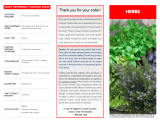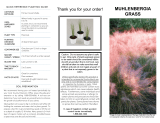Page is loading ...

**IImmaaggee oonn ccoovveerr iiss rreepprreesseennttaattiivvee ooff tthhee ttyyppee ooff ppllaanntt((ss)) iinn tthhiiss ooffffeerr aanndd
nnoott nneecceessssaarriillyy iinnddiiccaatti
ivvee ooff aaccttuuaall ssiizzee oorr ccoolloorr ffoorr tthhee iinncclluuddeedd vvaarriieettyy
.
QUICK REFERENCE PLANTING GUIDE
Partial sun.
Blaauw's PPink:
2 to 4 feet tall with
a similar spread.
Christina:
2 to 3 feet tall with a 3
to 4 foot spread.
Delaware VValley:
3 to 4 feet tall
with a similar spread.
Fashion:
2 to 4 feet tall with a 3
to 5 foot spread.
FlorAmore HHot PPink:
3 to 4 feet
tall with a similar spread.
FlorAmore LLavender:
3 to 4 feet
tall with a similar spread.
FlorAmore PPink:
3 to 4 feet tall
with a similar spread.
FlorAmore RRed:
3 to 4 feet tall
with a similar spread.
Johanna:
2 to 3 feet tall with a
similar spread.
Renee MMichelle:
3 to 4 feet tall
with a 4 to 5 foot spread.
Stewartstonian:
4 to 5 feet tall
with a similar spread.
Spring.
Evergreen.
Great for landscaping.
Adds a pop of springtime color.
Perennial
.
One plant per 12-inch or larger
container.
3 years.
LIGHT/SUN
EXPOSURE
USDA HHARDINESS
ZONES
PLANT TTYPE
PLANTING
DISTANCE
IN-GGROUND
CONTAINER SSIZE
TIME TTO RREACH
MATURITY
MATURE
HEIGHT // SSPREAD
BLOOM TTIME
FACTS OOF NNOTE
Thank yyou ffor yyour oorder!
Bursting into bloom at the first sign of spring,
Azaleas bid farewell to winter with an abundance
of bright, cheery blossoms. These evergreen
shrubs are a staple in the Southern landscape, but
can be enjoyed in nearly any part of the country.
Whether planted in beds, borders, containers,
or as a hedge, these tried-and-true shrubs will
electrify your landscape with eye-popping color.
Caution:
Do nnot aassume aany pplant iis ssafe tto eeat.
Only pparts oof pplants eexpressly ggrown tto bbe eeaten
should bbe ccons
idered eedible. AAs wwith aany pproduct
that iis nnot ffood, ccare sshould bbe ttaken tto mmake
sure tthat ssmall cchild
ren aand ppets ddo nnot iingest
any ppart oof tthe pplant tthat iis nnot eexpressly ggrown tto
be eeaten.
Unless specifically stated, this product is
intended for ornamental horticultural use only
and is not intended for consumption or ingestion
by humans or pets. Most plants are harmless,
but some contain toxic substances which can
cause adverse health effects. Furthermore, some
individuals and some animals are sensitive or
allergic to certain plants and precautions should
be taken to limit or avoid physical contact with
particular plants. Some plants have thorns or
spines that can be painful if handled.
In ccase oof iingestion ccontact aa ppoison
control ccenter iimmediately.
1-8800-2222-11222
At least 3 feet apart.
AAZZAALLEEAASS
5 to 9.

Adequate and consistent watering is essential during
your plant's first year in the garden. Infrequent, long
soakings of water that thoroughly saturate the soil
are more effective than frequent, light applications of
water.
Due to variable geographical and environmental
conditions, a specific watering schedule is difficult to
define. However, as a rule of thumb, you should not
allow the soil or the original root ball to completely
dry out. During the first summer, you may need to
water as often as every few days in periods of
drought and extreme summer heat. To determine if
your plant needs water, dig a few inches into the soil
next to the plant. If the soil is dry 2-3 inches below the
surface, it is time to water.
Overwatering can be as damaging as under watering.
Be sure that the area surrounding your plant has
adequate drainage to move water away from the
plant. If you choose to plant in a container, always
select one with drainage holes to prevent your
plant's roots from sitting in water.
WWAATTEERRIINNGG
FFEEEEDDIINNGG
Feed your plants once every 2-3 weeks during the
growing season with a water-soluble fertilizer for acid
loving plants. Discontinue feeding after September
1st so your plants can harden off for winter. Resume
fertilizing when new growth appears in the spring.
WWEEEEDDIINNGG MMUULLCCHHIINNGG
Keep the area around your plants free of weeds.
Weeds compete with surrounding plants for food,
water and light. Walk around the garden periodically
and pull weeds, including the roots, as soon as you
see them.
Apply a 2-4 inch layer of shredded bark, compost,
leaves, straw or other organic matter around your
plants to promote moisture retention, maintain even
soil temperatures and discourage weed growth.
Replenish the mulch as needed.
WWIINNTTEERRIIZZIINNGG
PPRRUUNNIINNGG
Azaleas may be pruned in summer if needed to
maintain a desired size and shape. At that time, cut
each plant back by as much as 1/3 its size. To avoid
removing developing flower buds, do not prune
azaleas in spring to fall.
CONTINUING CARE (Continued)
CONTINUING CARE
PLANTING INSTRUCTIONS
Important:
Thoroughly hydrate the plant by submersing
the root zone in a container of water for 10 minutes while
you prepare for planting.
1. Remove and discard the clear plastic bag from around
the pot.
2. After watering, remove the pot by holding the plant
upside down in one hand and squeezing the sides of the
pot with the other.
3. Prepare the root ball for planting by gently disturbing
the surface roots with your fingers, fork, or gardening tool
and pruning any damaged roots. This will encourage the
roots to begin growing outward into the new soil.
4. Dig a hole twice as deep and twice as wide as the plant's
root ball. Partially backfill the hole with soil and place the
plant into the hole. The top of the root ball should be level
with the ground surrounding the hole. Refill the hole with
soil, firming the soil around the plant with your fingers.
Check to be sure the plant is not planted too deeply. If it is,
raise the plant carefully and re-firm the soil.
5. Water thoroughly.
Watering thoroughly in late fall will greatly enhance
your plant's cold tolerance once the ground has
frozen.
Azaleas will benefit from mulching in cold areas.
The time to winterize your plants is in late fall. When
winterizing perennials, keep in mind that the root
system is the most vulnerable to cold damage.
Mulch heavily by mounding a 6-8 inch layer of
shredded bark, compost, leaves, straw or other
organic material around the base of each plant.
In very cold areas, containerized plants can be
brought into an unheated, protected area such as a
garage or cellar before temperatures drop below
freezing. Check soil moisture every 2-3 weeks and
water as needed during winter.
In spring, remove mulch from in-ground plantings.
Containerized plants should be moved back out
into the garden sunlight where they will begin to
repeat their yearly garden performance.
OUT OF THE BOX
Your plants have been shipped to you in pots. We urge
you to remove them from the shipping box and plant
them as soon as possible. Should planting be delayed due
to weather or other unforeseen circumstances, roll the
plastic bag down around each plant and place them near
a bright window or other sunny location. Keep them well-
watered in their pots until permanently planted. Once
planted, they begin setting roots and, as the weather
warms, begin showing new growth. Please plant as soon
as possible, provide reasonable care and be patient.
The foliage on potted plants may appear slightly wilted or
yellow upon arrival. This is due to the stress of shipping
and is usually nothing to worry about. Water the plant
thoroughly, place it in a shady location and remove any
foliage that does not recover.
SHIPPED AAS SSHOWN
AZALEAS
SOIL PREPARATION
We recommend having your soil tested periodically by
your local County Extension Office (www.nifa.usda.gov/
extension or by calling 1-800-333-4636). A soil test can
determine if your soil needs any amendments to enhance
the growth and performance of your plants.
Ideal garden soil is easy to dig in and drains well while still
holding the nutrients and water vital to plant growth. To
prepare a bed for in-ground planting, spade or till the soil
to a depth of roughly 12-18 inches. Next, spread a 2-4 inch
layer of organic matter such as compost, shredded leaves
or peat moss over the soil and mix well.
/

